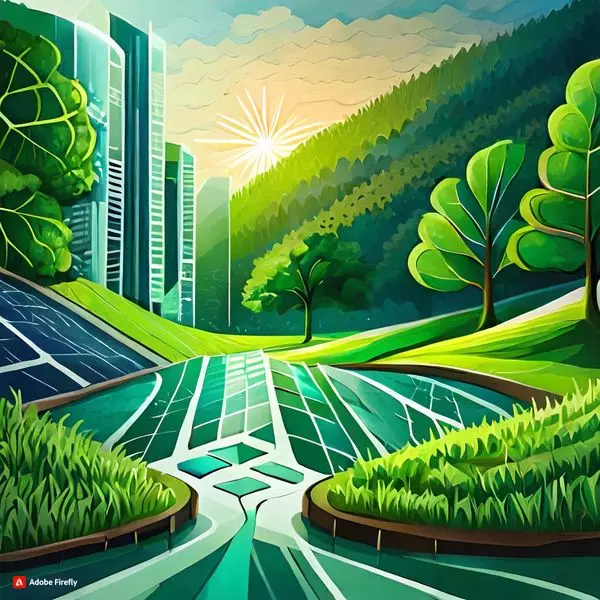In a world where the call for sustainability reverberates louder than ever, technological innovations are emerging as powerful allies in the pursuit of a greener future. Cloud 7 IT Services Inc stands at the forefront of this transformative movement, spearheading initiatives that integrate renewable energy, foster smart building solutions, and champion responsible e-waste management. As the latest episode of “Status Go” unfolds, we delve into five pivotal types of sustainable technology and their potential to drive positive change across industries.
Renewable Energy Integration:
At the core of green technology lies the integration of renewable energy sources, a game-changing strategy to reduce carbon footprints. Cloud 7 IT Services Inc is actively involved in harnessing the power of solar and wind energy, ushering in an era where sustainable energy becomes a norm rather than an exception. This shift not only mitigates environmental impact but also lays the foundation for a more resilient and eco-conscious energy landscape.
Smart Building Solutions:
Cloud 7’s commitment to sustainable technology extends to efficient energy management through smart building solutions. By offering cutting-edge networking solutions, the company empowers organizations to optimize energy consumption within their infrastructures. This not only results in cost savings but also contributes significantly to the overall reduction of environmental footprints associated with traditional building management systems.
Efficient Cooling Systems:
In a bid to address the environmental impact of data centers, Cloud 7 IT Services prioritizes energy-efficient cooling systems. By adopting innovative cooling technologies, the company is making strides in reducing energy consumption, aligning with global efforts to curb carbon emissions associated with data processing and storage.
E-Waste Management:
Taking a stand against the e-waste crisis, Cloud 7 IT Services emphasizes responsible disposal practices. This commitment not only aligns with a circular economy model but also demonstrates a dedication to minimizing the environmental repercussions of electronic waste. Through these efforts, Cloud 7 contributes to the creation of a sustainable and closed-loop approach to technology consumption.
Remote Work Solutions:
Cloud 7’s commitment to sustainability extends beyond infrastructure to facilitate remote work solutions. By reducing the need for daily commutes and lowering office energy consumption, the company champions a more sustainable approach to workforce operations. This not only aligns with environmental goals but also responds to the changing dynamics of the modern workplace.
Sustainability Consultation:
Cloud 7 IT Services takes a holistic approach by providing sustainability consultations to businesses. By guiding organizations on the integration of green technology into their operations, Cloud 7 contributes to an ecosystem where sustainability is not just a buzzword but a strategic imperative. This collaborative effort ensures that businesses can navigate the complexities of sustainability, creating a lasting impact on the environment.
Key Takeaways from “Status Go Goes Green”:
Green IT:
The episode sheds light on the concept of Green IT, emphasizing the incorporation of renewable energy sources, efficient data center practices, and electronic waste recycling. This approach, when adopted by organizations, results in a reduced carbon footprint and optimized IT infrastructure, aligning technological advancements with environmental responsibility.
Human Resource Technology and Workforce Automation:
As automation becomes prevalent, the importance of upskilling and reskilling the workforce cannot be overstated. Human resource technology and workforce automation, discussed in the episode, enable organizations to navigate this shift successfully, ensuring a harmonious balance between technological advancements and human capital utilization.
ESG Reporting:
Environmental, Social, and Governance (ESG) reporting emerges as a key driver of sustainability innovation. Integrating technological advancements into ESG strategies allows organizations to reduce risks, enhance efficiency, and mitigate their environmental impact. The episode underscores the need for data accuracy, transparency, and authenticity in ESG reporting.
Smart and Green Buildings:
The concept of smart and green buildings takes sustainable technology to the next level. By utilizing advanced monitoring systems, organizations can optimize energy efficiency, enhance air quality, and contribute to creating environmentally friendly workspaces. The integration of sustainable materials further supports the development of eco-conscious infrastructures.
Integrating Sustainable Technology with Business Strategy:
The guest expert emphasizes that sustainable technology should not be a standalone solution but rather integrated into the overall business strategy. Aligning goals with business drivers, including partnering, efficiency, risk reduction, innovation, and change implementation, ensures the seamless integration of sustainable technology into organizational operations.
Empowering CIOs to Drive Sustainable Change:
The role of Chief Information Officers (CIOs) in driving sustainable change is highlighted in the episode. By aligning priorities with business goals, CIOs can significantly impact the overall success of their organizations. The episode underscores the importance of CIOs’ involvement in enterprise-wide initiatives and the measurement of performance metrics derived from sustainable technology.
Training for a Sustainable Future:
Green Training Associates, featured in the episode, emphasizes the critical role of power skills, or soft skills, in professional development. Beyond technical expertise, skills such as emotional intelligence, relationship-building, critical thinking, and adaptability are essential for IT professionals to successfully implement sustainable technology.
Cultivating an Organizational Culture Shift:
A strong organizational culture is pivotal in driving sustainable change. The episode underscores the importance of training and relationship-building networks to foster a growth mindset and facilitate a culture shift necessary for embracing sustainable technology. By investing in the growth and development of IT professionals, organizations can enhance their impact, employee engagement, and retention.
Aligning Sustainable Technology with Key Business Goals:
Gartner’s report on top strategic technology trends in 2023 emphasizes the importance of aligning technology priorities with key business goals. Protecting and growing the brand, attracting and retaining talent, and growing revenue are identified as key priorities for technology leaders. Sustainable technology is seen as crucial in achieving these goals by enhancing profitability, reducing costs and risks, and attracting a new generation of talent that values environmental responsibility.
Incorporating sustainable technology is not just an option; it is a responsibility that organizations and technology leaders share. As the episode unfolds, it becomes evident that the potential of sustainable technology to drive positive change is immense. By embracing green IT, upskilling the workforce, integrating sustainable practices, and aligning technology with business strategy, organizations can pave the way for a greener future. These initiatives not only drive innovation and mitigate risks but also contribute to building sustainable organizations that are resilient in the face of evolving challenges.
Guest expert Pam Sammarco expresses gratitude to Jeff Ton for the invitation to “Status Go” and encourages listeners to connect for further discussions and preparations for Gartner’s predictions for 2025. Sammarco’s expertise in embedding sustainability into technology offers a valuable resource for technology leaders seeking to spearhead sustainable practices and drive a positive impact on the world.
In a world where the global community is awakening to the urgent need for sustainable practices, technology stands as a beacon of hope. As industries and individuals alike strive to minimize their environmental footprint, sustainable technology emerges as a catalyst for innovative solutions that harmonize progress with the well-being of our planet.
Also Read: ” New Threat To Democracy” : India To Clamp Down On Deepfakes With New Regulations & Penalties













